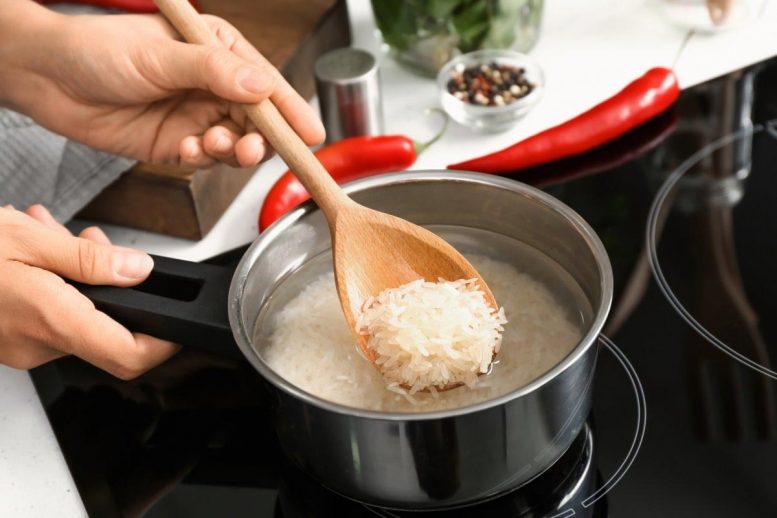
Researchers from the Institute for Sustainable Food have discovered a home-friendly method of cooking rice that significantly reduces arsenic content, according to a study published in the Science of the Total Environment.
A study from the Institute for Sustainable Food has found a new cooking method, the ‘parboiling with absorption method’ (PBA), that can reduce arsenic levels in rice by over 50% in brown rice and 74% in white rice without losing micronutrients.
- University of Sheffield study shows cooking rice in a certain way removes more than half of the naturally occurring arsenic compared to rinsing alone
- Study shows no loss of micronutrients for both brown and white rice during the recommended ‘home-friendly’ process
- Scientists call for further research on how to remove arsenic in areas of poor water quality and regional rice varieties
A new research paper, published on October 29, 2020, in Science of the Total Environment shows that cooking rice in a certain way removes over 50 percent of the naturally occurring arsenic in brown rice, and 74 percent in white rice. Importantly, this new method does not reduce micronutrients in the rice.
Previous research from the University of Sheffield that found half of the rice consumed in the UK exceeded European Commission regulations for levels of arsenic in rice meant for the consumption for infants or young children.
This new study tested different ways to cook rice to try and reduce the arsenic content and the team from the Institute for Sustainable Food found that by using a home-friendly way of cooking rice, the ‘parboiling with absorption method’ (PBA), most of the arsenic was removed, while keeping most nutrients in the cooked rice.
The PBA method involves parboiling the rice in pre-boiled water for five minutes before draining and refreshing the water, then cooking it on a lower heat to absorb all the water.
Arsenic, which is classified as a Group 1 carcinogen by the International Agency for Research on Cancer, is water-soluble – so it accumulates in rice, which is grown in flooded fields more than other cereals. Arsenic exposure affects almost every organ in the body and can cause skin lesions, cancer, diabetes, and lung diseases.
Rice is known to accumulate around ten times as much arsenic as other cereals. In rice grains arsenic is concentrated in the outer bran layer surrounding the endosperm. This means that brown rice, (unmilled or unpolished rice that retains its bran) contains more arsenic than white rice. This milling process removes arsenic from white rice but also removes 75-90% of its nutrients.
“For rice consumers, this is excellent news. There are genuine concerns amongst the population about eating rice due to arsenic. Previous studies have shown that cooking rice in excess water could remove arsenic but the problem is it also removes nutrients.
Our aim was to optimise the method to remove arsenic while keeping maximum nutrients in the cooked rice. Our newly developed method, PBA, is easy and home-friendly so that everyone can use it. We don’t know the amount of arsenic in each packet rice we buy; even though brown rice is nutritionally superior to white rice as our data shows, it contains more arsenic than white rice. With our new method we are able to significantly reduce the arsenic exposure while reducing the loss of key nutrients.
We highly recommend this method while preparing rice for infants and children as they are highly vulnerable to arsenic exposure risks.”
— Dr. Manoj Menon
Environmental Soil Scientist in the Department of Geography at the University of Sheffield and lead author of the study
Reference: “Improved rice cooking approach to maximize arsenic removal while preserving nutrient elements” by Manoj Menon, Wanrong Dong, Xumin Chen, Joseph Hufton and Edward J. Rhodes, 29 October 2020, Science of The Total Environment.
DOI: 10.1016/j.scitotenv.2020.143341
The research was funded as part of the UK’s Science and Technology Facilities Council (STFC) Food Network+ along with partial financial support from School of Health and Related Research (ScHARR) at the University of Sheffield. The network brings together more than 750 international and multidisciplinary researchers from across the agri-food sector to work with experts from STFC’s research facilities, all with the aim of solving some of the world’s greatest food sustainability challenges. Until April this year, the network was led by the University of Manchester. This is now being led by academics at the Institute for Sustainable Food.
The Institute for Sustainable Food at the University of Sheffield brings together multidisciplinary expertise and world-class research facilities to help achieve food security and protect the natural resources we all depend on.

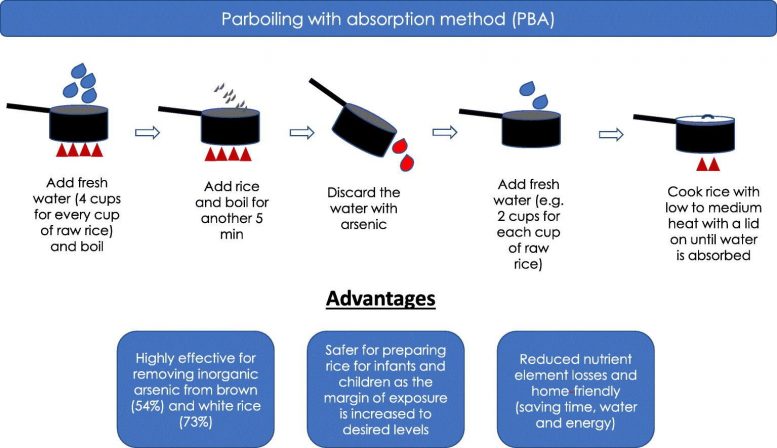




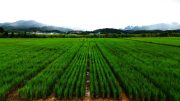
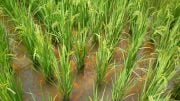
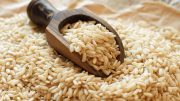
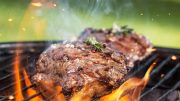
Can we follow this same process using a rice cooker?
That was a question I asked as well.
I have always oar-boiled and rinsed my rice prior to cooking and after 5 min.
I would suggest par boiling before putting it in the rice cooker.
Hope this helps.
So are you to re-boil already parboiled rice? Or is this when you purchase non-parboiled rice.
This is the way Persians cook the rice for thousand years, And they knew that this method removes most of Arsenic. No t a new method
This is how Africans cook rice. This is below subpar.
This is the way Nigerians cook rice for thousands of years. I have never cooked my rice without parboiling it. My parents never cooked rice without parboiling it first
What about those who use a rice cooker like me? I never knew there was arsenic in rice? So, do this method then transfer to rice cooker??
Dumbasses, Persians been cooking rice this method for thousands of years.
Ancient persians, not the mullahs!
Do you really need to be so nasty in your comments, obviously not everyone would know how Persians or Africans cook rice🤔🙄 Being kind over rules being right!!🙏
Right! Putting negative comments shows who you are! Many do not know this information about rice!
Sitka,thanks for your kind words. Some people are truely ignorant.
Nobody is showing anything here, the problem is, this invention is not new. Period
Everyone gave their opinion, atleast you should be happy to learn that other cultures been doing this a for a long time.Not making it feel as if they have no right to their opinion. This might make the scientists to review thier research and even find out more. Dey do like say no body fit talk.shhh
English motherf##ker. Do you speak it?
What about rice which has been soaked for several hours and well rinsed beforehand, is the parboiling method the same in this case? And does this apply equally for brown and white rice?
What ever people have done for thousands of years, does not make it scientifically valid. Why is that even an argument?
I believe the complaint is more about the description of this as a “new way of cooking rice,” when it isn’t new. Had the story read “scientists determine optimal method of cooking rice to remove arsenic” you wouldn’t see these complaints.
Interesting.
We kurds, just like persians and other middle eastern nations wash the rice becore cooking 5-7 times with warm water or until the water becomes clear, then we cook the rice in fresh water depe ding on how much water it needs per cup, as each grain is different (long, mid, fine and etc.)
This is not a new method, so those scientists just spent money to write what we already do. Thnk you for the confirmation though.
Who the hell cook the rice and then drain the rice and cook it again? It ruins the rice bruh.
Just wash the rice properly, measure water with finger and put it in the rice cooker. Tastes much better than doing this. Good food is better than body
Does organic rice need to be parboil too?
Rice grown in southern states of US have the most arsenic.Cotton grown in the south was sprayed with an arsenic insecticde so there is lots of arsenic in the soil. Arsenic occurs naturally in other soils. Organically grown rice stiil draws arsenic from the soil, 10 x as much as other grains. Lundberg claims their Caliornia grown rice has the least amount.
What kind of research. If we discard water after heating it looses all the nutrition.
We been cooking rice with your describe way as well as other way means with out using your way, But did not feel any deffrence. Is there any way to test out is arsenic clear or still there.Thanks
We the north-east indian are doing that for a decades…..its nothing new for us….its just an old custom for cooking rice….
south east asian here . this is what we do already
If boiling for 5 minutes removes 75 percent of arsenic, is the remaining 25 percent arsenic safe to eat??? How many parts parts per billion in the final rice? If it’s more than 10 ppb it’s still not safe.
This is what Nigerians and other Africans have been doing for years. How can some people “discover” what’s already being done?
As a sushi chef, we wash 5-6 times wash rice eventhough prewashed and delivered to our kitchen.it has been carried on many centuries in Asian countries and been trained staff. I can not understand of your study.
This is the how the whole world except the so called “English countries” are boiling rice for thousands of years :p
What about the “lazy girl” way of cooking rice? Boil in bags. Has that rice been washed prior to bagging? I never knew rice contained arsenic. If it contained a lot of arsenic, the Chinese should be keeling over by now. I always use boil in bags because I cook for just me and it is quick and easy. Please advise. Thank you.
I would be afraid of cooking any food in plastic…that’s a whole new toxin being introduced.
This is the way Afghans and persion have cooked rice for 1000 years
Actually we wash very well the rice and soaked it overnight with clean water and before cooking boil water put the soaked rice and boil until soften then drain it completely and add seasoning oil and salt and water and cook it with the lid on until water absorbed then leave it on lowest heat for 30 min more with a cloth on under the lid to absorb steam . Delicious 😋 basmati rice is the best to cook!
Hi Saidi. Thanks for commenting. My question is, if you parboil the rice, how do you know how much water to use for the 2nd boiling so it doesn’t become mushy?
I understand that rice grown in the south eastern states in United States has a lot of arsenic. That the rice from the north west area has the least or even none. The soil in the south east was once used for tobacco and that plant deposited arsenic into the soil. And the rice plant picks it up. Anyone have knowledge on this??
This method is not new for indians, we already practiced it since many generations.
Here is the actual article, which answers many of your questions
https://www.sciencedirect.com/science/article/pii/S0048969720368728
Good to know Merci Thanks
https://www.sciencedirect.com/science/article/pii/S0048969720368728
Quoted from above article:
“However, rice can be a significant source of inorganic arsenic (iAs, comprised of AsIII and AsV), a poison and Group 1 carcinogen, according to the IARC (International Agency for Research on Cancer, 2012), when grown in an arsenic-contaminated environment (e.g. soil or water).”
So if rice is not grown in contaminated environment, there will not be any Arsenic in it.
Arsenic occurs naturally and binds to grains molecularly. As Arsenic was used in many American states as a pesticide for so many years before it was banned, it remains in the soil.
If you are eating American-grown grain rice, you should assume it contains Arsenic &, thus, should take steps to remove as much of that Arsenic as you can prior to cooking it and serving it to your family.
1. Why does the government allow use of poisonous food?
2. Why eat poisonous food?
What is new about this way of cooking rice? The Indian had been cooking rice this way since who knows when. Ask any Indian and they will tell you. This method will also remove a certain amount starch from the rice.
Michael O’shea is an evil lawyer in Rocky River, Ohio.
So buy rice NOT from China & don’t worry about it.
Arsenic occurs naturally and binds to grains molecularly. As Arsenic was used in many American states as a pesticide for so many years before it was banned, it remains in the soil.
If you are eating American-grown grain rice, you should assume it contains Arsenic &, thus, should take steps to remove as much of that Arsenic as you can prior to cooking it and serving it to your family.
Plz do not teach Asians how to cook rice ok. We Indians when we are cooking rice we drain off the water in which we cooked the rice completely. Grand parents lived up nearly 100 years and ate rice daily cooked this way. Theseessages are from the wheating growing countries as they mountains of wheat which they cannot flight off. Wheat is the unhealthiest if all grains full of gluten. People in the west are obese and constipated. You scientists teach your westerners a good diet. Lay off
Nobody is trying to teach Asians how to cook rice!, YOU came here to read the article!,,,
Just buy organic🙄🙄🙄🙄🙄🙄
All rice leaches Arsenic from the soil; being produced by organic principles does not change this literal fact, as one would understand had they employed fifth-grade reading comprehension skills.
A food being “organic” doesn’t make it magically “pure,” as it’s still necessary to rinse farm produce and take contamination precautions when storing and cooking meats & other perishables.
🙄🙄🙄🙄🙄🙄
🙄🙄🙄🙄🙄🙄
Is baby rice cereal good to eat or is it contaminated too?
Hmmm, the rice I buy often Says on the package, “DO not rinse as u will wash off the vitamins”, What to believe?
The scientists.
Labels like these are created by marketing executives to get buyers to purchase the easier-to-cook/more-expensive-to-produce white rice, instead of the more nutrient-dense brown rice.
Rice a Roni 🤯
This is not new, In Thailand… Thai cooked rice this way for centuries before the rice cooker has discovered.
Oh yah kill. Kill. Thanks for hurting moms and dad’s and fams everywhere. STAND UP AGAINST THE LIES OF GOVERNMENT !!!
I cook my rice by building a fire on Main Street and shooting it full of holes.
Us Hebrew Israelites have known this for many years. This isn’t new. Many cultures do this. Tbh…Science is just the study of things God made. There’s nothing new under the sun. Scientists are a little extra. …renaming animals who already have a name that was given by Adam and Eve. Who calls a dog “ Canis lupus familiaris?” I roll my eyes in Jesus’s Name at those deceptive fallen angels. Always trying to take credit from what other cultures have discovered. We know about the land far away they are hiding in our own language. 2 continents in one sea and 5 in the other. We know about the crystal enclosure scientists will never be able to Break. We know what and who dwells on the eastern side of the world.
Unfortunately, I hate to inform you, unlike yourself who thinks he and everyone in your tiny world knows everything in the universe there are people who aren’t afraid to say they don’t know something. Your ego is beyond believable. How dare you be so rude and unkind to speak in such a way and belittle others. Take a step back and review yourself and learn some compassion and manners for others.
Not to mention, neither Adam nor Eve are believed to have called the canine ancestor a “d”,” “o,” “g.”
They also knew nothing of “Jesus,” as he didn’t come along until millennia later.
What about cooking it in an Instant Pot? How does this factor in?
That is how rice was cooked all over India, probably since ages, and then came the pressure cooker.
Good for confirming that centuries old method is better.
Part of science is to look at existing methods. To call this a new method is a joke. Many cultures do this not only because of arsenic but also to reduce bacillus cereus count. Maybe i should publish that: “Scientists discover a revolutionary way to reduce bacterial count in rice”
Funding should go to proper science and not regurgitation publishing.
Btw, look up the persian tahdig, it makes the process even better because you get a crisp crust at the bottom of the pot or rice cooker
Not a new way to cook rice, my friend. This is how I was taught to cook rice as a teenager and it’s the way Indians, Persians and Africans have traditionally cooked rice for decades and centuries
This how Haitian cook rice boiled the water @ 100% degree and we wash the rice and cook it hello peoples what about bacteria .
My Chinese grandparents ate rice every day of their lives (sometimes multiple times a day) and lived to be in their 90’s. They would just rinse the rice til clear before cooking. Maybe the rice is just worse today than in their generation (like everything else). We’re all going to die of something, some sooner than others. Just enjoy that bowl of rice!!
The Asians have been doing this for many years. It’s only because now people find cooking a chore that they use shortcut ways of doing things.
This is nothing new.
I don’t like to measure so I have been cooking rice like pasta. I use a big pot of water and dump in a little rice. When it’s done I strain and serve. However I only eat long grain. Probably won’t work with sticky rice
Here’s a thought. How do we know that restraunts cook rice this way or save money and time by just cooking the rice without rnsing it?
This method saves both money & time.
Compare:
_ time in man-hours & necessary water required to properly rinse the rice the cook it
_ for 1 C of uncooked rice
_ 3.5 C of water to rinse 5-7 times
_ 2 C of water to cook
VS
– negligible time in man-hours & significantly less water
_ for 1 C of uncooked rice
_ 4 C of water to parboil
_ 2 C of water to cook
That’s pretty simple math.
Dang page refreshing while proofing what I typed ….
Trust is,
_ 3.5 C of water to rinse 5-7 times, EACH, so 17.5 C – 27.5 C
Here’s a thought. How do we know that restraunts cook rice this way or save money and time by just cooking the rice without rinsing it?
Unless you’re psychic – and just like any other question about have any given dish is prepared at every other restaurant – it’s a simple matter of asking your server.
This seems easy enough to do, and sounds really worthwhile. I think I’m going to adopt this method..
I love medium grain rice, will be parboiling from now on
Keep in mind that fluoridated water often contains arsenic and both arsenic and fluoride are concentrated by boiling. So don’t use tap water. Carbon filters will not remove fluoride. Only distillatikn or reverse osmosis.
Berkey water filters will filter out fluoride from tap water if you use the fluoride filters.
Kurt,
That doesn’t answer the matter raised in the article or by Susan.
This is funny, there’s nothing new about this research. This is how most Nigerians cook rice and they’ve always known it removes the chemical
What does this mean for rice krispies? Should I just use them as rat poison? Really, who gives a flying squirrel here. Add more arsenic so we can get rid of some of the idiot commentators, plus we could make it the number one meal for Whitehouse staff. Let’s throw in some radium water too!
Forget COVID, climate change, etc. This is ground breaking science.
I have been cooking rice for the past years! Will probably die of something else than arsenic in rice!
Won’t change my cooking method now!
I’m 72 years old!
Very interesting; those who claim they discover this new metod of cooking rice that can remove arsenic from rice should come over to the traditional rice producers and consumers here in Asia. We have two basic ways of cultivating rice, dry land or ‘hill rice’ and wet cultivation; the former is less exposed to arsenic contamination!Also, PBA is our ‘traditional’ cooking metod!
Lets see, Parboil the rice, and then cook it again fully…? Hey, that sounds like exactly how my grandma used to do it, and her granny’s grandma before her. Gentlemen, I mean to take nothing away from the value behind your scientific analysis. However, to claim that its a new discovery by scientists is somewhat presumptuous, especially when this “discovery” has been around in the southern cultures of India, and I suspect, in other lands as well, for centuries.
Not a new idea. You are taking us decades back
All these people saying it is not a new wsy of cooking are missing the point. The study was to reduce Arsenic or had these cultures undertaken this study already?
Thank you
It’s so much more important to disseminate research studies that confirm more helpful-vs-harmful ways of doing things than to get caught up in the semantics of a single word used by a media reporter in the article title.
You’d think people who follow Global Science news would understand this
The study confirms removal of arsenic through scientific measurements. The practices done 1000 years ago had no evidence so these scientists did everyone a favour. So stop yapping about your culture.
Thank you
It’s so much more important to disseminate research studies that confirm more helpful-vs-harmful ways of doing things than to get caught up in the semantics of a single word used by a media reporter in the article title.
You’d think people who follow Global Science news would understand this
No evidence that cancer is more prevalent among rice eating people so this scientists wasted time and money
Do you have a verifiably curtain for that but if nonsense?
Because there are myriad studies proving that people exposed to more of X-carcinogen over time developed significantly more X-related cancers than people who have lower rates of exposure to that same carcinogen.
I will not argue whether or not this works at removing arsenic. However, I will argue that it is NOT home friendly. You have to heat the water to a boil, add the rice, boil for 5 minutes, drain, add water again, and then cook the rice; more time, more water, and more energy.
Incorrect.
This method saves both money & time.
Compare:
_ time in man-hours & necessary water required to properly rinse the rice the cook it
_ for 1 C of uncooked rice
_ 3.5 C of water to rinse 5-7 times EACH, so 17.5 C – 27.5 C in total
_ 2 C of water to cook
VS
– negligible time in man-hours & significantly less water
_ for 1 C of uncooked rice
_ 4 C of water to parboil
_ 2 C of water to cook
That’s pretty simple math.
, EACH, so 17.5 C – 27.5 C
Hola , con todo respeto, me hago varias preguntas:
-en que parte del grano entero se concentra el arsenico?
-en la cascara?
-el proceso de pulido elimina la mayor parte del arsenico?
-donde se concentra el arsenico en el arroz pulido?
-las tradiciones de lavar y precocinar el arroz surgieron como tecnicas para quitar el arsenico o como tecnicas para quitar el exceso de almidon , particulas extrañas y veneno?
-desde cuando se consume el arroz pulido?
-desde cuando las madres que cocinan arroz saben de la toxicidad del arsenico?
-desde cuando la presencia de arsenico en el arroz no lavado ha sido reconocido como un problema para la salud?
OMG! I’m so hungry! I wish it would cool off here in the midwest so I could start making these! I honestly think you should do a fall/winter cookbook!
https://uniqop.com/recipe
I actually have never had pad thai earlier than, however this looks exact! It is also something I might actually strive like for a home unique occassion.https://uniqop.com/
Are folks referring to thousand year old traditions referring to brown rice?
Hi, Finding professionals is easy with Organic Providers. Search our website to instantly connect with business and professionals. For professionals, our website works as a powerful tool for attracting more clients. digital marketing
Hello, Bamboo Steamer is a gadget that is used in cooking. This gadget will help you create dishes such as Dim Sum, Sushi, Pork Bun (Baozi), Zhaliang, and many more. On this post, you will learn about how this gadget may look like, what are the different types of Bamboo Steamer, the steps on how to use it, and its benefits when cooking. Cooking Bamboo Steamer has all the information about bamboo steamers and how to cook delicious meals using this device.Buy Bamboo Steamer on Amazon
You CAN discover things that have already been discovered or invented by others—just ask any baby or toddler about all the things they discovered today.
But you CANNOT invent something that someone else has already invented, even if you honestly THINK you have invented it simply because you are ignorant of the earlier inventor. Invention status usually goes to the first human who made something (although it gets fuzzy if the first human copied his invention from a non-human animal or an alien-to-earth-being).
There is just no way this isn’t way way too much water for 1 cup of rice.
Did everyone know that bens original bag says…”To retain vitamins, DO NOT rinse before or drain after cooking”
pretty much opposite what this site says…that’s interesting…
In paraboiling the rice, I think adding alpha lipoic acid to the rice,
should chealate the arsenic out of the rice.
This should reduce the arsenic in the rice by 100%
There is an INBRED semen sucker on this thread going by the name of H. FYI, Africans are the most ancient peoples on the planet. It started with them and was shared with the Persians. Try READING, you maggot. P
That’s old like, put in bowl and wash is basically what he doing learned that in Japanese language class lol
Rice bioaccumulates heavy metals ( toxic metallic elements) from the soil and water which it is grown.
The study was to determine which cooking method, if any, reduces the As in the rice since As is the prominent toxic element rice accumulates.
The study found that thoroughly rinsing and then parboiling (put into already boiling water for five minutes) and then draining and cooking reduce the As concentration the most.
Not just rinsing, not just soaking, but a step wise method had the most reduction of As.
Most people do not know about the As let alone the tested and measured methods of reducing it.
If your culture does this exactly the same, great! Smart folks.
If your culture does one or more of these steps, that is a great start! Add the missing step if you are concerned about chronic arsenic poising!
Growing rice in soil/water that is free of As is the best.
The artificial rice making machine is a revolutionary invention that has the potential to revolutionise the way we make rice.
I am continuously looking online for tips that can facilitate me.
I went over this website and I believe you have a lot of good info , saved to bookmarks (:.